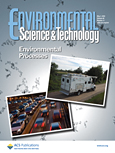Environmental Science and Technology 46(9)
Overview of new articles on POPs in a new issue of the Environmental Science and Technology journal.

Ed Sverko, Gregg T. Tomy, Chris H. Märvin, and Derek C. G. Muir
pp 4697–4698
- Short chain chlorinated paraffins (SCCPs) are a complex mixture of branched and straight-chained alkanes ranging from C10–C13 with varying degrees of chlorination. Their primary uses include additives in cutting and engine oils for heat dissipation and as flame retardants in plastics. SCCPs were used as early as World War II where they were incorporated into military uniforms for flame retardancy. Today, SCCPs are a high production volume chemical with total production estimates in the United States and Europe ranging from 7.5 to 11.3 kt per year. China is widely regarded as the largest producer of CPs in the world with an estimated 140 factories and total production of ca. 600 kt in 2007 alone.
Emission and Atmospheric Transport of Particulate PAHs in Northeast Asia
Yayoi Inomata, Mizuo Kajino, Keiichi Sato, Toshimasa Ohara, Jun-Ichi Kurokawa, Hiromasa Ueda, Ning Tang, Kazuichi Hayakawa, Tsuyoshi Ohizumi, and Hajime Akimoto
pp 4941–4949
- The emission, concentration levels, and transboundary transport of particulate polycyclic aromatic hydrocarbons (PAHs) in Northeast Asia were investigated using particulate PAH measurements, the newly developed emission inventory (Regional Emission inventory in ASia for Persistent Organic Pollutants version, REAS-POP), and the chemical transport model (Regional Air Quality Model ver2 for POPs version, RAQM2-POP). The simulated concentrations of the nine particulate PAHs agreed well with the measured concentrations, and the results firmly established the efficacy of REAS/RAQM2-POP.
D. Kupryianchyk, M. I. Rakowska, J. T. C. Grotenhuis, and A. A. Koelmans
pp 4975–4984
- Adding activated carbon (AC) to contaminated sediment has been suggested as an effective method for sediment remediation. AC binds chemicals such as polycyclic aromatic hydrocarbons (PAHs), thus reducing the toxicity of the sediment. Negative effects of AC on benthic organisms have also been reported. Here, we present a conceptual model to quantify the trade-off, in terms of biomass changes, between the advantageous PAH toxicity reduction and the negative effects of AC on populations of benthic species. The model describes population growth, incorporates concentration-effect relationships for PAHs in the pore water and for AC, and uses an equilibrium sorption model to estimate PAH pore water concentrations as a function of AC dosage.
Advection Dominated Transport of Polycyclic Aromatic Hydrocarbons in Amended Sediment Caps
Philip T. Gidley, Seokjoon Kwon, Alexander Yakirevich, Victor S. Magar, and Upal Ghosh
pp 5032–5039
- Typical sand caps used for sediment remediation have little sorption capacity to retard the migration of hydrophobic contaminants such as PAHs that can be mobilized by significant groundwater flow. Laboratory column experiments were performed using contaminated sediments and capping materials from a creosote contaminated USEPA Superfund site. Azoic laboratory column experiments demonstrated rapid breakthrough of lower molecular weight PAHs when groundwater seepage was simulated through a column packed with coarse sand capping material.
Paola Meynet, Sarah E. Hale, Russell J. Davenport, Gerard Cornelissen, Gijs D. Breedveld, and David Werner
pp 5057–5066
- We collected urban soil samples impacted by polycyclic aromatic hydrocarbons (PAHs) from a sorbent-based remediation field trial to address concerns about unwanted side-effects of 2% powdered (PAC) or granular (GAC) activated carbon amendment on soil microbiology and pollutant biodegradation. After three years, total microbial cell counts and respiration rates were highest in the GAC amended soil. The predominant bacterial community structure derived from denaturing gradient gel electrophoresis (DGGE) shifted more strongly with time than in response to AC amendment.
Xingbao Wang, Yong Wang, Jingwen Chen, Yuqin Ma, Jing Zhou, and Zhiqiang Fu
pp 5126–5133
- Understanding the transformation mechanism and products of xenobiotics catalyzed by cytochrome P450 enzymes (CYPs) is vital to risk assessment. By density functional theory computation with the B3LYP functional, we simulated the reaction of 2,2′,4,4′-tetrabromodiphenyl ether (BDE-47) catalyzed by the active species of CYPs (Compound I). The enzymatic and aqueous environments were simulated by the polarizable continuum model. The results reveal that the addition of Compound I to BDE-47 is the rate-determining step.
2.5.2012




